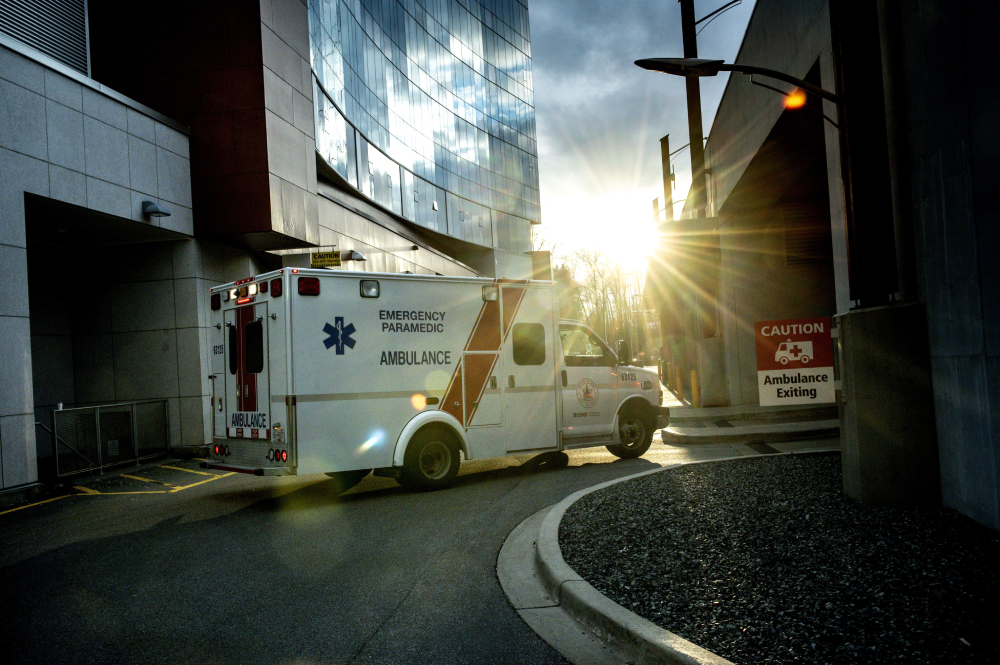In an emergency, every minute can feel like an eternity.
When Sandra Smith pulled over at the scene of a collision between a car and an RV in Smithers this week, she couldn’t guess how much time had passed since the crash — maybe a minute or two. Others were beginning to stop and walk toward the badly damaged car, one carrying a first aid kit.
Wanting to help, Smith pulled out her phone and dialled 911. It was 10:52 a.m. Within seconds, an operator took the call and transferred it to BC Ambulance Service, staying on the line with her while she waited for a dispatcher to answer.
The two minutes that followed felt like much longer, Smith says, as she sat on hold waiting to speak with someone.
“I thought, well, this is ridiculous. I know where the ambulance station is, six blocks away. I’m just going to go and get them,” she remembers, after realizing others at the scene were also on hold with the ambulance service.
Smith says she “tore off like a rocket” to the station less than two kilometres away, where she banged on the windows of the ambulance bay. The station was empty and two ambulances appeared to be out on calls. So she darted to the nearby fire hall, just a couple of blocks away in the northern community’s compact downtown, and reported the crash just after 11 a.m.
Five minutes later, and more than 15 minutes after she’d first happened upon the crash, she heard their vehicle respond.
“It feels like an eternity,” says the Smithers resident about the time she waited on hold, knowing people were trapped in the smaller vehicle. “It was awful.”
According to Shannon Miller, communications officer with BC Emergency Health Services, a passing ambulance transporting a patient to hospital came upon the scene on Highway 16 at 11 a.m. — about the time Smith was reporting the incident to the fire hall and roughly eight minutes after the collision occurred.
A 911 call from the scene finally made it through about one minute later, Miller adds, just after the paramedics called for more resources. A second ambulance arrived at 11:09 a.m. and a third shortly after, she says.
That meant a nine-minute wait on hold while people were trapped in the crumpled car.
RCMP would later report that one person was pronounced dead at the scene. BC Emergency Health Services says a second person was transported to Bulkley Valley District Hospital in serious condition before being transferred by air ambulance to receive a higher level of care at a hospital in the Lower Mainland.
According to a GoFundMe campaign set up to help the family cover travel and funeral expenses, it’s unknown how long the second victim, a 13-year-old boy, will remain in hospital.
As B.C.’s ambulance service struggles to keep up with overlapping health emergencies like the overdose crisis and the pandemic, the province has promised more resources to fix the system as delays have increased.
But advocates say more is needed to ensure a timely response in life-or-death situations.
“Unfortunately, it’s not a new issue,” said Troy Clifford, provincial president with the Ambulance Paramedics and Dispatchers of BC. “It’s escalated lately, despite the addition of resources.”
When callers dial 911, the call is answered by a service known as E-Comm, where operators then direct calls to fire, police or ambulance dispatchers. BC Ambulance Services has three call centres in the province — one in Vancouver to service the Lower Mainland, one in Victoria to service Vancouver Island and a third in Kamloops, which services the rest of the province.
Because ambulance dispatch centres take overflow from one another, delays are an indication that call volumes are high provincewide and not within a specific region, Clifford says. “That means it was busy at every centre if they couldn’t answer the calls.”
According to E-Comm, Smith’s call was one of more than 5,000 made for emergency services on Oct. 20 — an average call volume for a Wednesday in mid-October, says the organization, which also provides dispatch services for police and fire departments. The time to answer 911 calls averaged one second, with the longest being 25 seconds, it says.
But delays occurred once calls were transferred to the ambulance service, says E-Comm communications manager Kaila Butler.
“There were no notable spikes in overall call volumes throughout the day, although we did receive a higher number of requests for the ambulance service,” she says. “During this time, we were seeing longer delays in transferring 911 callers with a request for ambulance to BC Emergency Health Services.”
Clifford says the backlog is a combination of staffing shortages and increasing call volumes — and it has been ongoing for some time. Since the start of the pandemic, he says call volumes spiked by almost 25 per cent, a significant increase over the six-per-cent annual increase traditionally seen in the province.
He says that pre-pandemic, there were typically 1,400 to 1,500 calls a day for ambulance service in the province. After the province eased pandemic restrictions in June, he says call volumes increased to more than 1,700 a day.
The heat dome in late June, when daily calls peaked at more than 2,000 calls a day, also illustrated vulnerabilities in the province’s emergency health services.
The Health Ministry says calls for ambulance service reached a similar level to those seen during the heat dome over the October long weekend.
“And then you put that on top of shortages of paramedics and dispatchers to fill the current positions we have, we’re already understaffed and under-resourced, so it puts extra pressure on,” Clifford says. “That’s really why you’re seeing these delays. We need more dispatchers to answer calls.”
The provincial government has promised those resources are coming.
Following June’s deadly heat wave, the province announced new measures to bolster emergency health services, including adding 85 full-time paramedic positions, eight of them in the north, all based in Prince George. In addition, it promised 30 new full-time dispatchers and 22 more ambulances.
In September, in what the province described as “the largest hiring push in B.C.’s history in rural and remote locations,” the Health Ministry promised it would invest $3 million into a health-care worker rural retention program for northern communities, in addition to further bolstering B.C.’s ambulance service.
Two dozen rural ambulance stations are being converted from on-call to 24-7 staffing with eight full-time paramedics this month, included in the northern communities of Burns Lake, Fort St. James, Houston, Vanderhoof, Chetwynd and Fort Nelson.
In addition, 26 smaller and more remote ambulance stations — including Atlin, Bear Lake, Granisle, Dease Lake, Port Clements, Southside and Stewart — will have more stable paramedic jobs in November, the province says.
Health Minister Adrian Dix called the changes “interim actions” with more announcements coming this fall to secure health-care human resources in the north.
At the time, Dix noted that the region had the highest COVID-19 numbers in the province, something that hasn’t changed in the five weeks since.
Although positive cases in Smithers dropped slightly last week, the community of just over 5,000 has been among the highest for COVID-19 in the province recently, with the Health Ministry announcing a month ago that it would begin flying intensive care patients to Vancouver Island and the Lower Mainland for care.
According to the BCCDC, per capita cases in Northern Health remained among the highest in the province between Oct. 12 and 18, with several local health areas to the north and west of Prince George leading the province’s per capita case numbers.
On Tuesday, the Bulkley Valley District Hospital in Smithers declared a COVID-19 outbreak, saying testing had identified four inpatients who tested positive for the disease, one of whom had died. Enhanced outbreak precautions at the hospital include restricted visitor access, additional symptom monitoring and limiting staff and patient movement within the facility.
As of today, 22 patients with COVID-19 were receiving critical care treatment in northern hospitals and 74 people were hospitalized with the disease, significantly higher than numbers earlier in the pandemic.
The province introduced tough new restrictions for Northern Health last week, including banning gatherings for those who remain unvaccinated.
But despite measures to reduce pressure on the health-care system and increase resources, Clifford says more is needed.
He says low pay and the instability of the ambulance service’s on-call model make hiring a challenge. “Particularly in the north, in rural and remote Indigenous communities, because that’s where we’re having our biggest challenge in recruiting into the profession,” he adds.
“We need a lot more to make sure that we’re not having these delays,” he says. “We are still seeing incredible out-of-service levels of ambulances, particularly in rural and remote [areas] but also in the Lower Mainland.”
And he says the resulting delays take a toll on everyone — those needing care, dispatchers, paramedics and the callers themselves.
“Sometimes that’s their only experience and they’re dealing with an incredible emergency or crisis,” he says. “Every moment, we know, in a critical intervention could mean the difference between life and death.”
Smith says she doesn’t want anyone to experience the helplessness of not being able to get through to an ambulance when it’s needed.
“You’re sitting there waiting and you can see people are trapped in the car,” she says. “You can hear them and you can hear that someone in there is scared, and you’re just sitting there on hold.” ![]()
Read more: Health, BC Politics
















Tyee Commenting Guidelines
Comments that violate guidelines risk being deleted, and violations may result in a temporary or permanent user ban. Maintain the spirit of good conversation to stay in the discussion.
*Please note The Tyee is not a forum for spreading misinformation about COVID-19, denying its existence or minimizing its risk to public health.
Do:
Do not: